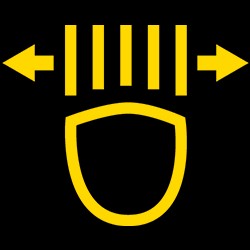Hyundai vehicles are equipped with advanced safety and convenience features, including the Adaptive Front Lighting System (AFLS). The AFLS enhances visibility by automatically adjusting the headlights based on steering angle and speed. However, like any complex system, the AFLS can malfunction, triggering a warning light on your dashboard. This article will explain the meaning of the Afls Light On Hyundai, common causes, and troubleshooting steps.
Understanding the Hyundai AFLS Warning Light
The AFLS warning light typically appears as a headlight symbol with curved lines indicating the turning direction. When illuminated, it signifies a potential issue with the AFLS. While the AFLS light itself might not indicate immediate danger, it’s crucial to address the underlying problem to ensure optimal headlight performance and safety.
Common Causes of AFLS Light on Hyundai
Several factors can trigger the AFLS warning light on a Hyundai. Here are some common culprits:
- Malfunctioning AFLS Sensor: The AFLS relies on sensors to detect steering angle and vehicle speed. A faulty sensor can provide inaccurate data, causing the system to malfunction and illuminate the warning light.
- Wiring Issues: Damaged or corroded wiring within the AFLS circuit can disrupt communication between components, leading to system errors and triggering the warning light.
- Bulb Failure: While less common, a burned-out headlight bulb can sometimes trigger the AFLS warning light. The system might detect the bulb failure and illuminate the warning light as a precaution.
- Control Module Problems: The AFLS control module is the brain of the system, responsible for processing sensor data and controlling the headlight actuators. A faulty control module can cause a variety of issues, including the illumination of the warning light.
- Low System Voltage: In some cases, a low battery voltage or charging system problem can trigger the AFLS warning light. The system might not have sufficient power to operate correctly, leading to errors.
Troubleshooting the AFLS Light
If the AFLS warning light illuminates on your Hyundai, here are some troubleshooting steps you can take:
- Check the Headlight Bulbs: Start by inspecting both headlight bulbs for any signs of damage or burnout. Replace any faulty bulbs.
- Inspect the Wiring: Visually examine the wiring connections related to the AFLS for any signs of damage, corrosion, or loose connections. Repair or replace any damaged wiring.
- Check for Diagnostic Trouble Codes (DTCs): Use an OBD-II scanner to retrieve any stored DTCs related to the AFLS. These codes can provide valuable insights into the specific problem.
- Consult a Professional Mechanic: If the basic troubleshooting steps don’t resolve the issue, it’s best to consult a qualified Hyundai mechanic. They have the necessary expertise and equipment to diagnose and repair complex AFLS problems.
Conclusion
The AFLS light on your Hyundai indicates a potential problem with the Adaptive Front Lighting System. By understanding the common causes and troubleshooting steps, you can address the issue promptly and ensure optimal headlight performance and safety. While some simple checks can be performed at home, consulting a professional mechanic is recommended for complex problems. Ignoring the AFLS warning light can lead to decreased visibility and potentially compromise your safety on the road.

